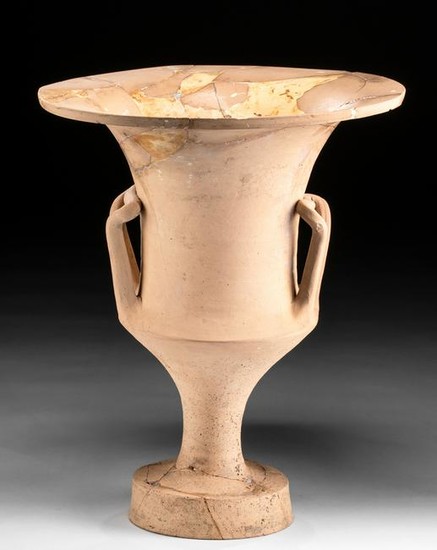Ancient Greek Pottery Calyx Krater
**First Time At Auction**
Ancient Greece, late Classical Period, ca. late 5th to 4th century BCE. A beautiful wheel-thrown buffware pottery calyx krater that was perhaps made to be painted but was never finished. The vessel has a discoid foot beneath a squat stem, an inverted, bell-shaped body, and a dramatically flared rim on top. The calyx krater style is similar to the bell krater and is so named for the low placement of its handles which have an upward curling form; early antiquarians thought the handles resembled the calyx of a flower. The earliest known example of this style is from the third quarter of the sixth century BCE and were made until the fourth century BCE, with their bodies slowly elongating over time. This vessel was perhaps made to be placed into a tomb. Size: 12" W x 14.8" H (30.5 cm x 37.6 cm)
Provenance: private J.H. collection, Beaverton, Oregon, USA, acquired in August 2017; ex-Artemis Gallery; ex-private J.A. collection, Grand Portage, Minnesota, USA
All items legal to buy/sell under U.S. Statute covering cultural patrimony Code 2600, CHAPTER 14, and are guaranteed to be as described or your money back.
A Certificate of Authenticity will accompany all winning bids.
We ship worldwide to most countries and handle all shipping in-house for your convenience.
#153256
Condition Report: Repaired from multiple pieces, with small chips along some break lines, restoration to areas of upper body and rim, and resurfacing with overpainting as well as adhesive residue along new material and break lines. Abrasions and nicks to rim, body, handles, and foot, with light encrustations. Nice earthen deposits throughout.
View it on
Estimate
Time, Location
Auction House
**First Time At Auction**
Ancient Greece, late Classical Period, ca. late 5th to 4th century BCE. A beautiful wheel-thrown buffware pottery calyx krater that was perhaps made to be painted but was never finished. The vessel has a discoid foot beneath a squat stem, an inverted, bell-shaped body, and a dramatically flared rim on top. The calyx krater style is similar to the bell krater and is so named for the low placement of its handles which have an upward curling form; early antiquarians thought the handles resembled the calyx of a flower. The earliest known example of this style is from the third quarter of the sixth century BCE and were made until the fourth century BCE, with their bodies slowly elongating over time. This vessel was perhaps made to be placed into a tomb. Size: 12" W x 14.8" H (30.5 cm x 37.6 cm)
Provenance: private J.H. collection, Beaverton, Oregon, USA, acquired in August 2017; ex-Artemis Gallery; ex-private J.A. collection, Grand Portage, Minnesota, USA
All items legal to buy/sell under U.S. Statute covering cultural patrimony Code 2600, CHAPTER 14, and are guaranteed to be as described or your money back.
A Certificate of Authenticity will accompany all winning bids.
We ship worldwide to most countries and handle all shipping in-house for your convenience.
#153256
Condition Report: Repaired from multiple pieces, with small chips along some break lines, restoration to areas of upper body and rim, and resurfacing with overpainting as well as adhesive residue along new material and break lines. Abrasions and nicks to rim, body, handles, and foot, with light encrustations. Nice earthen deposits throughout.



